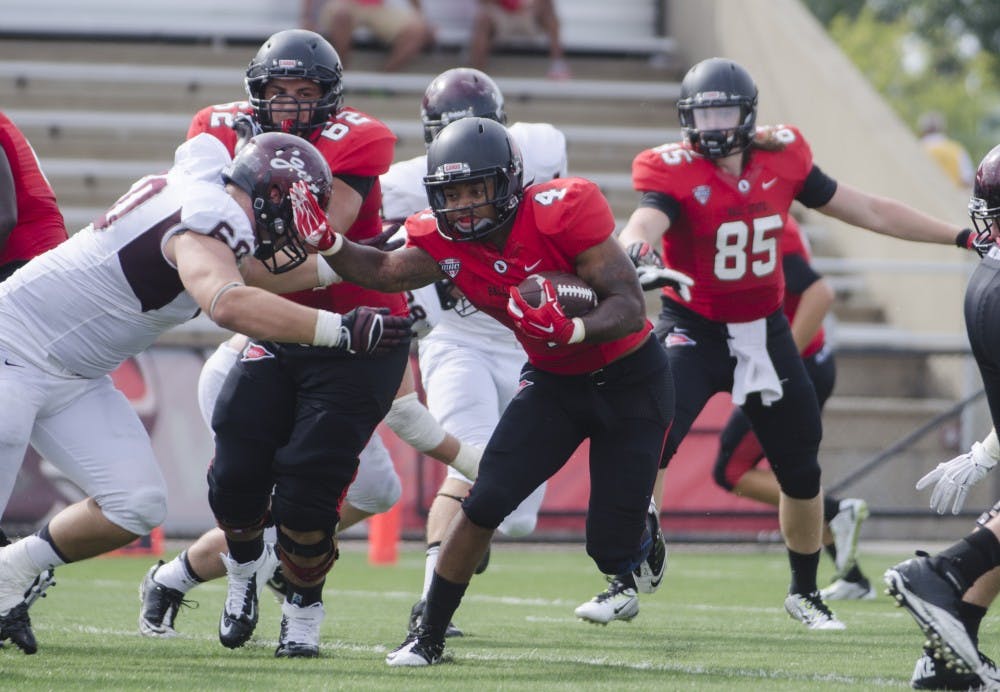Horactio Banks still remembers the play from practice, on Nov. 13, 2013, less than 12 hours before the Ball State football team took on Northern Illinois in a critical Mid-American Conference matchup.
He took the handoff and ran a stretch play to the left, waiting for his blockers to set up. Not a player near him, he planted his left leg, and it gave out. He crumpled to the ground. No player had touched him.
His season was over.
Banks didn’t know it at the time, but he tore his anterior cruciate ligament. He said he didn’t hear a pop, snap or any other sound typically heard when a player tears the ACL, so he didn’t initially think the injury was serious.
“I never felt anything like it before,” Banks said. “I actually didn’t think my knee was torn because I was able to get up and hobble over to the sideline.”
He underwent an MRI on Thursday, and learned the result on Friday. He had surgery on Nov. 29, 2013, the day after Thanksgiving, at Ball Memorial Hospital. The result was a scar just over two inches long, running along his left knee, and the beginning of an arduous recovery process.
ACL injuries are notoriously dangerous and difficult. Even when fully healed, the chance a player returns to the same athletic form achieved in the past isn’t guaranteed.
“Initially it was kind of disbelief and not a lot of faith he would come back from it,” running backs coach Justin Lutsig said.
During the season, Banks had made a name for himself with speed and elusiveness. He accumulated 616 yard and seven touchdowns, averaging 6.3 yards per carry, playing the role of change-of-pace running back in a dynamic 2013 offense when relieving Jahwan Edwards.
They seemed like distant memories in the days after surgery, when all he could physically do was lay in bed.
Banks was on painkillers to lessen the pain in his leg, and had a large lump of fluid buildup around his knee. He said his leg felt like dead weight, unable to move it on his own.
“I had zero control. I couldn’t lift it up, I couldn’t do anything, I didn’t have any strength,” Banks said. “After so long, I was able to do things on my own.”
He started rehabilitation just a few days after surgery, but there was no running, lifting, jumping or anything resembling physical activity.
He’d contract his quads, over and over. It was all he could do, a sign of how far he’d need to go to be back on the field.
Walking was a task, Banks used crutches for the first week he was on his feet. It didn’t take long for him to be walking under his own power again, but he was far from healthy.
With his rehab increasing, there was one everyday activity that challenged Banks above all: getting to his home on the third story of Windermere Place Apartments.
“There was a point I was walking up those stairs sideways instead of going up them straight,” Banks said. “It was just easier that way.”
Banks said each step on those stairs tested him, a version of rehab that didn’t require a trainer’s supervision, and the constant bending of his knee improved his range of motion.
The rehab continued at Scheumann Stadium under the watchful eye of athletic trainer Shawn Comer and in the weight room by David Feeley, director of strength and confitioning.
But through spring and summer, frustrations mounted. Banks said there was never a fear for re-injury, but Lustig disagreed.
“I think the hardest thing was this summer, when he got really cleared to play,” Lustig said. “Coach Feeley would complain all the time about the lack of confidence in his knee -- I think he was certainly scared in the back of his mind about hurting it again or coming back too soon.”
Banks would go through a workout successfully, then attempt it the next day and not be able to complete it.
“We got to the end of summer conditioning and I just still wasn’t where I wanted to be. I started thinking, ‘I’m not going to be ready for camp,’” Banks said. “The first day of camp came and I was still trying to trust my knee.”
When he started practicing, Banks said there’s no problem running and making moves, but the hardest part was trying to come to a stop.
He didn’t want to put too much pressure on his knee, trying to suddenly stop his momentum.
Banks said he drew inspiration from other athletes who had gone through ACL tears, like Minnesota Vikings running back Adrian Peterson.
“If one human being can do it, I can do it. No matter the stage or trainers, you’re still a man at the end of the day,” Banks said. “There’s not much more they can do to fix a knee that our trainers aren’t doing.”
Later during practice, Banks started testing himself. He said he’d suddenly take off, sprinting as fast as possible, gaining trust that his knee was fully healed.
In Ball State’s week one matchup with Colgate, Banks faced the most difficult test to date: full contact at full game speed.
13 carries and 134 yards later, the knee appears to be just fine. Lustig said there’s no doubt Banks is back to being fully healthy, and the game against Colgate is proof.
10 months later, hundreds of workouts and countless steps up the stairs of Windermere later, Banks is healthy.
“There was a point in time when I couldn’t do this, I couldn’t do this for a long time,” Banks said. “There’s somebody out in the world who can’t play football again -- I just go out and attack the day, like for somebody else who can’t do it.”


